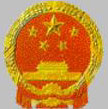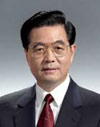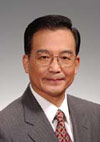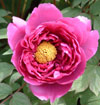| Name of the country |
The People's Republic of China |
| Capital city |
Beijing |
| Population |
1305.76 million (by 2005) |
| Area |
China has a territory area of 9.6 million square km, second to Russia and Canada,with a sea area of about 4.73 million square km. |
| Location |
In East Asia, border on the west Pacific Ocean |
National flag

|
The National Flag of the PRC is a red rectangle emblazoned with five stars. The proportion of its length and height is 3 to 2. The upper left of the face of the Flag is studded with five yellow five-pointed stars. One of the stars is bigger than the others, with its circumcircle's diameter being three-tenth of the height of the Flag, and is placed in the left; the other four stars are smaller, with their circumcircle's diameter being one-tenth of the height of the Flag, encircling the big star on its right in the shape of an arch. |
National anthem
|
March of the Volunteers (lines: Arise, those who do not want to be slaves! We will use our flesh and blood to build another Great Wall. China has reached the brink of national collapse. All the people have been making their last outcry. Arise! Arise! Arise! All our hearts become one. Let us face the enemy's gunfire. March on! Let us face the enemy's gunfire. March on! March on! March on! On!) |
|
National Emblem

|
The National Emblem of the PRC features Tiananmen Gate beneath the five shining stars, encircled by ears of grain and with a cogwheel at the bottom. The ears of grain, stars, Tiananmen and cogwheel are gold; the field within the circle is red, as are the ribbons festooning the bottom of the circle. |
| President

|
Hu Jintao, general secretary of the Communist Party of China (CPC) Central Committee, was elected president of the PRC on March 15, 2003. He was born in December 1942,in Jixi, Anhui Province,. |
Premier

|
Wen Jiabao is a member of the Standing Committee of the Political Bureau of the CPC Central Committee and premier of the State Council. He was born in Tianjin in September 1942. |
National flower

|
Peony |
| Ethnic groups |
There are 56 ethnic groups in China. The Han people make up 92 percent of the country's total population, totaling 1159.4 million; and the other 55 ethnic groups, 8 percent, totaling 106.43 million. |
| Languages |
Of the 56 ethnic groups in China , the Hui and Manchu use the same language as Han people, while the rest groups have their own spoken and written languages. |
| Written languages |
23 ethnic groups have their own characters. |
| Religion |
The main religions are Buddhism, Taoism, Islam, Christianity, and Catholicism. Chinese citizens' right of the freedom of religious belief is protected by the Constitution and laws. |
| Main festivals |
New Year's Day (January 1), the Spring Festival (the New Year's Day by Chinese lunar calendar), International Labor Day (May 1), and the National Day (October 1) |
| Currency |
Renminbi (RMB) yuan |
| Time difference |
8 hours earlier than the Greenwich |
| Climate |
Most of the country is in the temperate zone, although geographically the country stretches from the tropical and subtropical zones in the south to the frigid zone in the north. |
| Topography |
High in its west and low in its east: mountain areas 33.3%, plateaus 26%, basins 18.8%, plains 12% and hills 9.9%. |
| Mountains |
Among the 19 mountains over 7,000 meters high in the world, seven are in China. The Qinghai-Tibet Plateau, known as "the roof of the world", has many high mountains. The Himalayas, with an average elevation of 6,000 meters, have the world's highest peak Mount Qomolangma, 8,848 meters above sea level. |
| Rivers |
The Yangtze River, 6,300 km long, is the third longest in the world after the Nile and the Amazon. The Yellow River, the second longest in China, stretching 5,464 km. |
| Canal |
The Grand Canal, 1,801 km long, is the longest man-made river in the world. Its cutting began in the fifth century BC. |
| Lakes |
The Poyang Lake on the middle and lower reaches of the Yangtze River is China's largest freshwater lake, with an area of 3583 sq. km; the Qinghai Lake on the Qinghai-Tibet Plateau is the country's largest salt lake, covering 4583 sq. km. |
| History |
China is one of the world's oldest civilizations with a chronicled history of more than 5,000 years. China has gone over a long history of primitive society, slavery society, feudal society and semi-feudal semi-colonial society and the present socialist society. In 221 BC, Qinshihuang established the Qin Dynasty, the first feudal autocracy in Chinese history, thereby unveiling a 2,000-year period of feudalism which was to last through a succession of dynasties such as the Han, Tang, Song, Yuan, Ming and Qing, a period which finally met its demise in the bourgeois democratic Revolution of 1911 by Dr. Sun Yat-sen. October 1, 1949 saw the founding of the People's Republic of China. |
![]()
